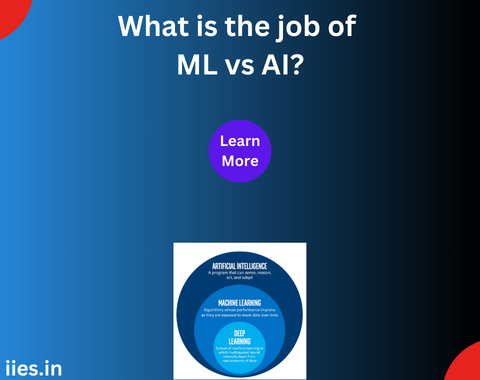
In the contemporary technological landscape, the terms “Machine Learning (ML)” and “Artificial Intelligence (AI)” are often used interchangeably, blurring the lines between their roles and functionalities. However, they represent distinct yet interrelated fields within computer science. Understanding the nuances of their respective jobs is crucial for grasping their impact on various sectors and the broader society. In this article, we delve into the job of ML versus AI, elucidating their core principles, applications, and diverging functions.
At its essence, Machine Learning is a subset of Artificial Intelligence that focuses on enabling machines to learn from data without explicit programming instructions. Its job revolves around the development of algorithms and models that allow computers to analyze vast amounts of data, recognize patterns, and make predictions or decisions based on learned insights.
One of the fundamental tasks of ML is classification, wherein it categorizes data into distinct groups based on similarities or features. This is exemplified in applications like email spam filtering, where ML algorithms classify incoming emails as either spam or legitimate based on past examples. Another crucial task is regression analysis, where ML models predict continuous outcomes, such as housing prices based on factors like location, size, and amenities.
Moreover, ML encompasses clustering techniques, which organize data into natural groupings without predefined categories, facilitating tasks like customer segmentation in marketing or anomaly detection in cybersecurity. Reinforcement learning, a subset of ML, is particularly notable for enabling machines to learn optimal behaviors through trial and error, as seen in autonomous vehicles or game-playing algorithms.
The job of ML practitioners involves data preprocessing, feature selection, algorithm training, evaluation, and fine-tuning. They navigate various ML algorithms, including supervised, unsupervised, semi-supervised, and reinforcement learning approaches, to develop models tailored to specific tasks or domains. Additionally, ML engineers grapple with challenges like overfitting, bias, and scalability, striving to optimize model performance and generalization.
Artificial Intelligence: The Synthetic Mind
Artificial Intelligence, on the other hand, encompasses a broader spectrum of capabilities aimed at mimicking human intelligence in machines. Its job extends beyond learning from data to encompass reasoning, problem-solving, perception, natural language understanding, and decision-making.
At its core, AI seeks to imbue machines with cognitive abilities, enabling them to comprehend, interpret, and respond to complex stimuli in real-world environments. This is exemplified in natural language processing (NLP) systems, which enable machines to understand and generate human language, powering applications like virtual assistants, language translation, and sentiment analysis.
Furthermore, AI encompasses computer vision, where machines analyze and interpret visual information from images or videos. This underpins applications ranging from facial recognition and object detection to medical imaging diagnosis and autonomous surveillance systems. AI-driven robotics integrate perception, planning, and control algorithms to enable machines to interact intelligently with their surroundings, revolutionizing industries like manufacturing, healthcare, and logistics.
The job of AI researchers and developers involves exploring diverse subfields such as knowledge representation, automated reasoning, expert systems, and neural-symbolic integration. They design AI architectures and algorithms that enable machines to perceive, reason, and act autonomously, often drawing inspiration from cognitive science, neuroscience, and psychology.
Intersecting Realms: ML and AI Collaboration
While Machine Learning and Artificial Intelligence represent distinct domains with unique focuses and methodologies, they are deeply interconnected. ML serves as the engine driving many AI applications, providing the capability to learn from data and adapt to changing environments. In contrast, AI provides the overarching framework for integrating diverse cognitive abilities into cohesive intelligent systems.
Moreover, the symbiotic relationship between ML and AI is evident in the evolution of deep learning, a subfield of ML that has propelled significant advancements in AI. Deep learning architectures, such as artificial neural networks, enable machines to automatically learn hierarchical representations of data, leading to breakthroughs in speech recognition, image classification, and natural language understanding.
Furthermore, AI techniques like reinforcement learning and Bayesian optimization augment the capabilities of ML algorithms, enabling more efficient model training, hyperparameter tuning, and decision-making under uncertainty. Conversely, ML algorithms play a vital role in enhancing the learning and adaptation capabilities of AI systems, enabling them to continuously improve performance through feedback and experience.
Exploring Further: Delving Deeper into the Roles of ML and AI
As we navigate the intricacies of Machine Learning (ML) and Artificial Intelligence (AI), it’s imperative to delve deeper into their respective roles, applications, and the evolving landscape of these dynamic fields. Let’s explore some additional facets that illustrate the nuanced distinctions and interconnected nature of ML and AI.
Machine Learning: Unraveling the Layers
Within the realm of Machine Learning, there exists a rich tapestry of algorithms and techniques that underpin its functionality. Supervised learning, perhaps the most well-known paradigm, involves training models on labeled data, where each input is associated with a corresponding output. This enables machines to learn the underlying patterns and relationships within the data, allowing for accurate predictions on unseen instances.
Conversely, unsupervised learning tasks involve uncovering hidden structures or patterns within unlabeled data, without explicit guidance or supervision. Clustering algorithms, such as K-means or hierarchical clustering, group similar data points together based on inherent similarities, facilitating tasks like customer segmentation or data compression.
In conclusion, the job of Machine Learning versus Artificial Intelligence encompasses distinct yet complementary roles within the broader realm of computer science. Machine Learning focuses on enabling machines to learn from data and make predictions or decisions, while Artificial Intelligence seeks to imbue machines with cognitive abilities akin to human intelligence.
While ML serves as the foundation for many AI applications, AI provides the overarching framework for integrating diverse cognitive capabilities into intelligent systems. The collaboration between ML and AI continues to drive innovation across various sectors, transforming industries and shaping the future of technology and society.
Understanding the nuanced distinctions and synergies between ML and AI is essential for navigating the rapidly evolving landscape of artificial intelligence and harnessing its transformative potential for the betterment of humanity.
Indian Institute of Embedded Systems – IIES